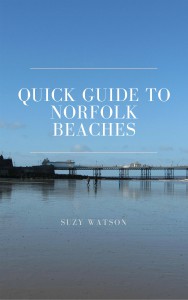- Explore Norfolk
- Walking Holidays
- Walsingham Way Pilgrimage Walking Route
- Walsingham Way Pilgrimage History
The Walsingham Way Pilgrimage History
The Extraordinary Story of England's Ancient Shrine
Miles and miles of Norfolk countryside, steeped in almost a thousand years of pilgrimage history! When you walk the Walsingham Way, you’re not just enjoying scenery - you’re literally following in the footsteps of countless pilgrims, kings and queens who have made this sacred journey since 1061.
I discovered the mysteries of Walsingham years ago when I first arrived in Norfolk, and have been fascinated by its extraordinary spiritual significance ever since; shrines in the windows, priests walking along the streets, chapels everywhere! There’s something very special about this place that continues to draw visitors from across the world, just as it has done for centuries.
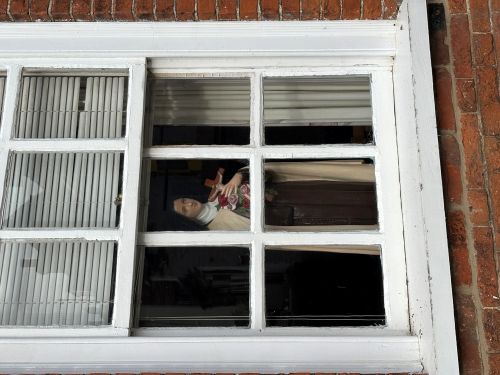
And on that point, you don’t need to be of religious mind to come and enjoy what Walsingham has to offer.
The Miraculous Origins of Walsingham
In 1061, during Edward the Confessor's reign, an extraordinary event occurred in Norfolk that would create England's most important pilgrimage site for centuries.
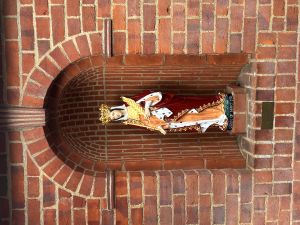
Richeldis de Faverches was a devout widow who owned the manor of Walsingham Parva. According to accounts passed down through generations, Richeldis experienced not one but three separate visions of the Virgin Mary.
These visions were remarkably specific. The Virgin Mary transported Richeldis spiritually to Nazareth, showing her the exact house where she’d received the Annunciation from Angel Gabriel. Mary then gave Richeldis precise instructions: measure this holy house and build an exact replica in Norfolk.
The significance of this request would create a physical link between England and the Holy Land – allowing pilgrims to experience a piece of Nazareth without undertaking the dangerous journey to the Middle East.
The construction faced immediate problems. The site Richeldis chose was marshy and waterlogged, making building impossible despite multiple attempts. The medieval builders just couldn't make progress on unstable ground.
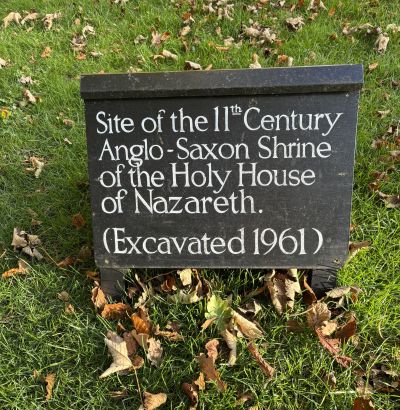
What happened next transformed Walsingham forever. After Richeldis spent a night in prayer, villagers awoke to find the Holy House completely built – but on an entirely different, dry location nearby.

This unexplained relocation became known as the "founding miracle" of Walsingham. It established the site's reputation for divine intervention and set in motion nearly 500 years of continuous pilgrimage before the Reformation.
I've visited the Holy House and seen it for myself.
England’s Nazareth: The Medieval Pilgrimage Powerhouse
Once established in 1061, the Holy House and Shrine of Our Lady of Walsingham quickly became the premier pilgrimage destination in medieval England. It’s fascinating to think that this small Norfolk village once rivalled Rome, Jerusalem and Santiago de Compostela in religious importance!
And the Walsingham Way counts towards 59 Kilometres of the Camino Ingles.
Did you know that Walsingham is thought to be home to the oldest shrine in the world dedicated to the Virgin Mary?

By the 14th and 15th centuries, Walsingham had actually outshone Canterbury’s shrine of St Thomas à Becket in both popularity and importance. While Canterbury drew huge crowds, Walsingham held a special place in people’s hearts because of its dedication to Our Lady — believed to be the most powerful intercessor with Christ.
Royal Pilgrims: Kings, Queens and Noble Devotees
Walsingham wasn’t just popular with ordinary folk - it attracted the most powerful people in the land!
King Henry III made his first pilgrimage around 1226 and his royal endorsement encouraged many subsequent English monarchs to make the journey.
The list of royal pilgrims includes:
- Edward I visited at least 12 times!
- Edward II made regular pilgrimages
- Edward III credited Our Lady of Walsingham with his victory at Sluys
- Henry VII offered thanks after his victory at Bosworth Field
- Henry VIII walked barefoot from Barsham to the shrine with Queen Katherine of Aragon, praying for a male heir
It’s incredibly poignant that Henry VIII was once a devoted pilgrim to Walsingham before later ordering its dissolution in 1538. The shrine that had stood for nearly 500 years was dismantled, and its treasures were seized by the Crown during the Reformation.
The Pilgrim Experience in Medieval Times
The medieval pilgrimage was no casual undertaking.
By the late Middle Ages, pilgrimages weren’t just spontaneous adventures. The Church made sure people neglect their families or work. Pilgrims needed permission from their Bishop and had to sort out their affairs properly, often making a will and clearing any debts before setting off.
The journey began with a special ceremony. Pilgrims would gather in their parish church, don their distinctive pilgrim attire, and receive a blessing for safe travel. The pilgrim’s costume was instantly recognizable:
- A broad-brimmed hat for protection from the elements
- A sturdy staff for support and defence
- A scrip (small bag) for carrying provisions
- Often a pilgrim badge to identify their destination
You can read more about why pilgrim routes are walked here.
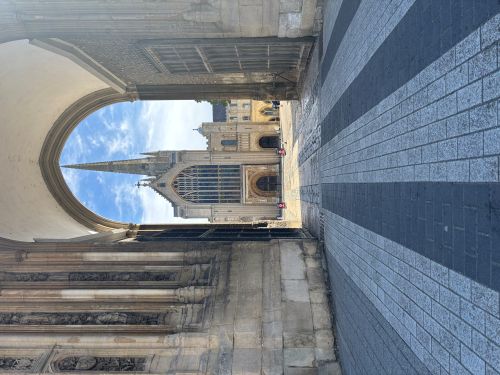
Many pilgrims heading to Walsingham would pass through Norwich, which was then the second largest city after London. The final stretch from Norwich to Walsingham became known as the Walsingham Way, a route that’s being revitalized today for modern pilgrims and walkers.
The Pilgrim’s Arrival: Walsingham in its heyday
When medieval pilgrims finally arrived at Walsingham after their long journey, they entered a busy village filled with inns, shops selling pilgrim badges, and churches. The small village was transformed by the pilgrim economy and possibly still is today! There are plenty of small shops selling all sorts of religious artefacts.
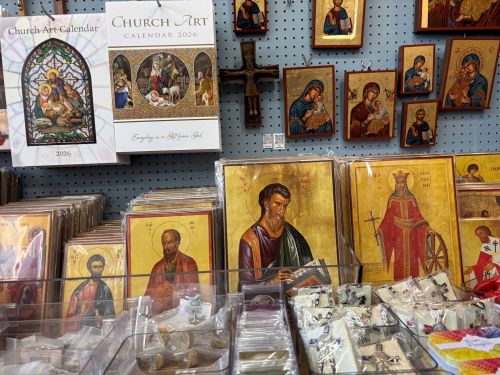
The highlight of any visit was entering the Holy House itself - a simple wooden structure that replicated the home where Mary received the Annunciation. Inside, pilgrims would pray before the statue of Our Lady of Walsingham, often leaving ritual offerings or requesting masses to be said.

Pilgrims also visited the holy wells of Walsingham, believed to have healing properties. Many would take Walsingham water home in small containers. This is another thing that is possible to do today.
Before leaving, pilgrims would purchase a Walsingham badge - typically showing the Annunciation scene - to prove they had completed their pilgrimage and to serve as a spiritual souvenir.
Walking the Walsingham Way Today
Our Walsingham Way walking package lets you experience this ancient pilgrimage route for yourself! Whether you’re spiritually motivated or simply love exploring history on foot, this journey connects you with centuries of pilgrims who travelled these same paths.
The route takes you through Norfolk countryside, quiet villages, and narrow lanes before arriving at Walsingham itself, where you can visit both the Anglican and Catholic shrines that have revived the pilgrim tradition in modern times.
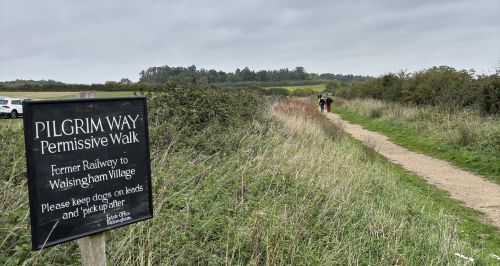
I’ve personally walked the whole of this route. There’s something moving about following ancient pilgrim paths and knowing that your footsteps overlap with those from nearly a thousand years ago (whether you gain a religious connection or are just walking for a contemplative break).
Remember that a pilgrimage route is for all faiths and none and you can find out a bit more in detail why pilgrimages are walked here.
Walsingham Through the Ages: From Ruin To Revival
The Dissolution of the Monasteries in 1538 was devastating blow to Walsingham. The priory was demolished, the Holy House destroyed, and the famous statue of Our Lady was taken to London and burned. For nearly 400 years, pilgrimage to Walsingham largely ceased.
But Walsingham’s story wasn’t over! In the late 19th and early 20th centuries, interest in pilgrimage revived. In 1897, Pope Leo XIII approved the restoration of the Holy House in the Catholic Church of the Annunciation, and in 1922, the Anglican shrine was restored in a new Holy House.

Today, Walsingham welcomes thousands of pilgrims annually.
The village hosts both the Anglican Shrine of Our Lady of Walsingham and the Catholic National Shrine, making it a unique site of ecumenical importance.
Beyond the Shrine: Walsingham Priory and Famous Snowdrops

While in Walsingham, don’t miss the incredible ruins of the original priory. These remains give you a sense of the grandeur of medieval Walsingham and how important this site once was.

If you visit in late winter, you’re in for a magical treat - Walsingham is famous for its spectacular snowdrop displays! The priory grounds are blanketed with these delicate white flowers, creating a truly magical scene all on its own. Find out more about Walsingham Priory and its spectacular snowdrops here!
Experience the Walsingham Way for Yourself!
Ready to walk in the footsteps of centuries of pilgrims? Our carefully curated Walsingham Way walking package gives you everything you need to experience this historic route:
- Detailed route guides and maps
- Hand-picked accommodation along the way
- Luggage transfers between stops
- Historical information to enrich your journey
- 24/7 emergency support
Whether you’re drawn by history, spirituality, or simply the joy of walking through beautiful Norfolk countryside, the Walsingham Way offers a unique and unforgettable experience.


